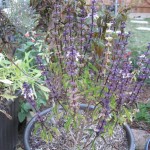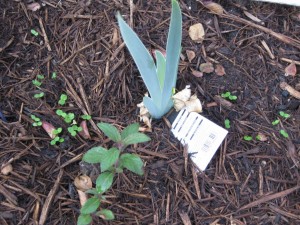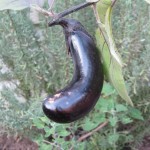We had a brief respite from the cold weather this week. And so far, this week has been full of rain. With temps in the 50s and 60s, I put out the ginger lilies so they could catch a bit of watering. The big one could use some trimming. These ornamental plants could make great indoor Christmas decor, if I were a bit more industrious in their upkeep.
Author: variadm
The pre-winter graveyard
It’s been a good two weeks since my last post. The climate has turned to rain to freezing temps back to chilly. Since we experienced a solid week of sub-freezing wind chills and temps, it’s natural that the annuals have succumbed to the frost. Where certain parts aren’t buried in leaves, my garden transformed into a graveyard in a matter of days. I hope to clear out the debris when the weather turns mild. Thankfully, the man started with pruning the Midnight Blue rose.
Goners: basils, vincas, marigolds, cosmos, ornamental peppers, salvia coccinea.
Dead top growth: caladiums, sweet potato ornamental vines (not sure if these Illusion potatoes will come back next year), callas, Sinaloa salvia, the purple oxalis in the blue bed, most of the asters.
Subject to change: foxtail ferns, Mexican heather.
Surprises: a few of the petunias are still green, all of the coreopsis have green foliage and appear to have grown, the larkspur seedlings appear unaffected by the freeze, one of the Autumn Embers azaleas actually had a (wilted) bloom on it, succulent planter looking pretty.
Annoyances: the yarrow continues to spread, weeds have invaded my lily bed!
Warning: images of dead plants ahead. On my Xmas wishlist: a compost bin from the city’s Park & Recreation dept.
Freeze alert
After deceptively mild weather for the Thanksgiving, it was evident that we were experiencing our last patches of warm weather before the cold front hit this weekend. My holiday shopping weekend was cut short by sudden drops in temperature, and I knew I would have to bring in my plants for the last time this year.
I missed the opportunity to bring in the eggplant yesterday, so I had to rush it into the bathroom greenhouse to see if it could be rescued. I’m not sure if the fruit will make it. It’s pretty short for what I’m used to in Chinese eggplants.
Outdoors, the damage from the overnight frosts has manifested into dead/wilted potato and basil plants. The traditional large leaf basils like Red Rubin and Genovese experienced the most damage. The lime, Pesto Perpetuo and Thai basil display browning less so. One of the Thai basil specimens appears to be laughing off the cold; but sooner or later, all the basils will be done.
The succulent planter seems to be hanging on. Whereas the petunia/caladium planter bowl shows signs of receding.
I found a surprise greeting me at one of the asters in the blue bed. A few blooms hid at the base of the plant, near the mulch line. I believe this one was Aster novi-belgii Believer.
Pansies, violas, ornamental kale, petunias, miscellaneous herbs, foxtail ferns, loropetalum, are all still hanging in there. The dusty millers must be enjoying their new location and this cool weather; they have doubled in size since I moved them from the front flower bed. I guess they prefer the protection. I expected the lemon verbena to die back down since it’s considered an annual, but it seems to enduring in the mixed planter box along with the chives, golden oregano, and aster cuttings. (Those are the remaining vincas hanging over from a neighboring planter. And a Red Rubin basil hiding out as well!)
Pre-Thanksgiving look at the garden
It’s that time of the year. Almost every year that I cook for the holidays, I make sure to use ingredients in my garden, even if it is only one sprig of rosemary. But since it’s been 10 days since my last post, I thought it time to do a little inspection.
The Shu ornamental pepper continues to hang on for dear life. Peppers are perennial in zones 9 and beyond, but here in my garden, it’s going to be a challenge to keep them alive in the ground during winter. My potted peppers have been sitting outside since this past weekend when we saw temps reach the high 70s. We’re back down to the high 30s to mid-40s during the evenings, but we will continue to reach the 70s in the daytime for the Thanksgiving holiday.
All the garlic have emerged and are looking tall.
The sage seems to appreciate the cooler weather; I used some sage leaves from this specimen for my turkey brine last night.
Those appear to be larkspur seedlings surrounding one of the irises. Unfortunately, the man sprinkled it heavily on one side not realizing I only had one pack of Shades of Blue Larkspur (Consolida ambigua). I may have to purchase another pack.
Finally, a good macro picture of the Oertel’s Rose yarrow blooms!
I love the white-mottled Snow-n-Summer asiatic jasmine foliage; emerging leaves are a beautiful shade of pastel pink.
The Autumn Monarch azalea is our only fall-blooming azalea this year. It received a fair amount of protection from the neighboring Hot Lips salvia this year, unlike the other azaleas on the opposite end of the bed.
A lone vinca has grown in the lee of an azalea. I had already pulled out its neighbors, but kept this one to see how it would fare. The petunias also appear unstoppable. Even with this crazy weather, they are continuously putting on new growth.
My eggplant doesn’t appear to put on much growth in the last 10 days; though the plant is leaning farther due to its weight. It still feels way to hard to the touch.
Valentine dianthus…what a beauty. All the dianthus in the garden favor this cool climate; most are putting on several buds if not blooming.
A surprise on the camellia: this bud has swelled to 5 times the size as other buds.
Lemon thyme: I plan on cutting several sprigs of this to insert into my turkey. The other herbs of course are looking fabulous. The Thai basil looks amazing with its flowery spires; I just dread how many seedlings I’ll get out of it. The Red Rubin basil also loves this cool weather. I am curious to see if they will endure into next year.
Garlic and other herbs
My garlic is coming up! I planted them the day before Halloween and here they are, making a showing! I counted 4 of them!
Sage is looking good. Eggplant looking good…I can’t wait to pick it!
Red Rubin basil has turned all purple again due to the cooler weather. Despite some very low temps it seems to be doing quite well compared to other basils.
I don’t know what this seedling is, but I suspect it is pineapple mint. Sniff test has been inconclusive. Several of them are popping up in the herb garden.
Loropetalum blooms. It’s also worth noting that this loropetalum is changing color. Beautiful!



































































